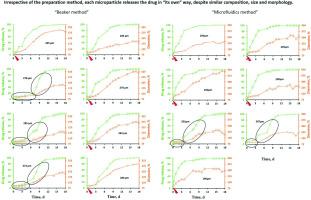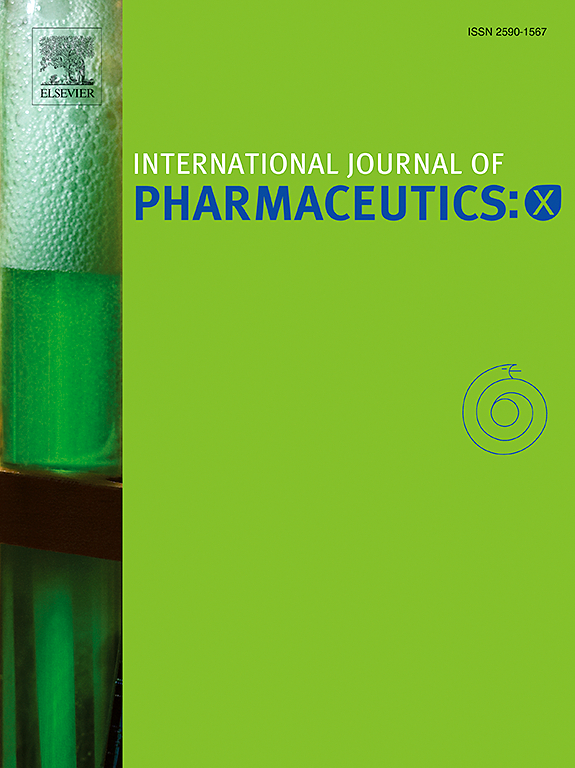使用微流体装置或烧杯制备的PLGA微粒的释放机制
IF 6.4
2区 医学
Q1 PHARMACOLOGY & PHARMACY
引用次数: 0
摘要
本研究的目的是为了更好地了解在“经典烧杯”和“微流体装置”下,通过乳化-溶剂萃取/蒸发制备的聚乳酸-羟基乙酸(PLGA)微颗粒的释放机制。通过光学显微镜、扫描电镜、x射线粉末衍射、x射线μCT和单个微颗粒在pH为7.4的磷酸盐缓冲液或琼脂糖凝胶(模拟活组织)中对布洛芬负载的微颗粒进行了药物释放测量。微流体装置的使用有助于制备具有较小尺寸分布的微颗粒。然而,在这种情况下,除了微粒大小外,内部系统结构对药物释放动力学也至关重要。有趣的是,即使是大小、组成和内部结构相似的微粒,外部结构表现出广泛的个体药物释放模式。无论制备方法和实验释放装置的类型如何,这都是正确的,并且可以解释如下:所研究的微颗粒具有连续的内孔网络和初始光滑的&;无孔的表面。一旦:(i)孔网络直接进入释放介质(例如,由于PLGA表面层的“弱点”),或(ii)系统开始实质性膨胀(在几天的滞后时间之后),药物释放就开始了。重要的是,每个微粒都有自己的特定结构,这决定了它释放药物的“方式”。此外,发现实验条件至关重要:周围琼脂糖凝胶的存在保护微颗粒免受对流流体流动造成的损伤,并阻碍微颗粒膨胀,从而减缓药物释放。本文章由计算机程序翻译,如有差异,请以英文原文为准。

Release mechanisms of PLGA microparticles prepared using a microfluidics device or a beaker
The aim of this study was to better understand the release mechanisms of poly(lactic-co-glycolic acid) (PLGA) microparticles prepared via emulsification - solvent extraction/evaporation using a “classical beaker” vs. a “microfluidics device”. Ibuprofen-loaded microparticles were studied by optical microscopy, SEM, X-ray powder diffraction, X-ray μCT and drug release measurements from single microparticles in well agitated phosphate buffer pH 7.4 or agarose gel (mimicking living tissue). The use of a microfluidics device facilitated the preparation of microparticles with a less broad size distribution. However, in addition to the microparticle size, the inner system structure was found to be also of utmost importance for the resulting drug release kinetics in this case. Interestingly, even microparticles with similar size, composition and inner & outer structure exhibited a broad spectrum of individual drug release patterns. This was true, irrespective of the type of preparation method and experimental release set-up, and could be explained as follows: The investigated microparticles were characterized by a continuous inner pore network and an initially smooth & non-porous surface. Drug release set on as soon as: (i) the pore network got direct access to the release medium (e.g., due to a “weak point” in the PLGA surface layer), or (ii) substantial system swelling started (after a lag-time of several days). Importantly, each microparticle had its own, specific structure, which determined “its way” to release the drug. Furthermore, the experimental conditions were found to be of key importance: The presence of a surrounding agarose gel protected the microparticles from damage caused by convective fluid flow, and hindered microparticle swelling, thus, slowing down drug release.
求助全文
通过发布文献求助,成功后即可免费获取论文全文。
去求助
来源期刊

International Journal of Pharmaceutics: X
Pharmacology, Toxicology and Pharmaceutics-Pharmaceutical Science
CiteScore
6.60
自引率
0.00%
发文量
32
审稿时长
24 days
期刊介绍:
International Journal of Pharmaceutics: X offers authors with high-quality research who want to publish in a gold open access journal the opportunity to make their work immediately, permanently, and freely accessible.
International Journal of Pharmaceutics: X authors will pay an article publishing charge (APC), have a choice of license options, and retain copyright. Please check the APC here. The journal is indexed in SCOPUS, PUBMED, PMC and DOAJ.
The International Journal of Pharmaceutics is the second most cited journal in the "Pharmacy & Pharmacology" category out of 358 journals, being the true home for pharmaceutical scientists concerned with the physical, chemical and biological properties of devices and delivery systems for drugs, vaccines and biologicals, including their design, manufacture and evaluation. This includes evaluation of the properties of drugs, excipients such as surfactants and polymers and novel materials. The journal has special sections on pharmaceutical nanotechnology and personalized medicines, and publishes research papers, reviews, commentaries and letters to the editor as well as special issues.
 求助内容:
求助内容: 应助结果提醒方式:
应助结果提醒方式:


